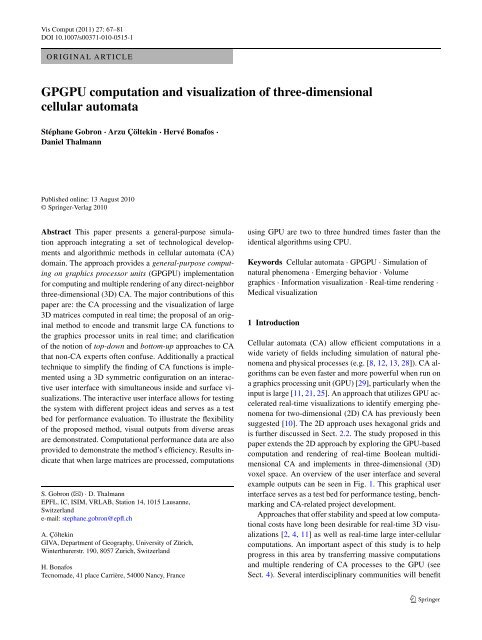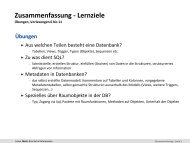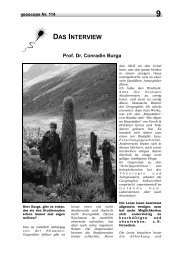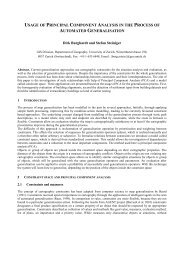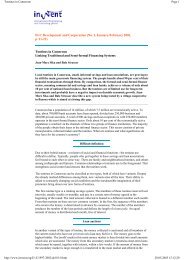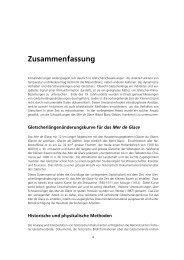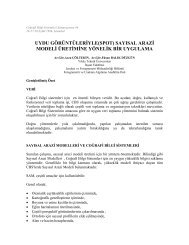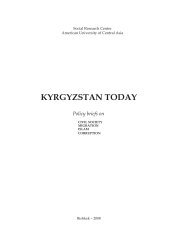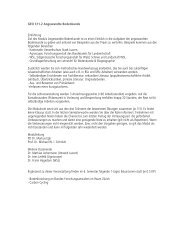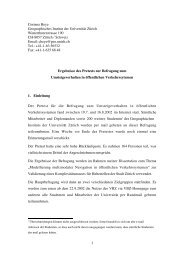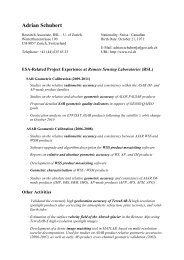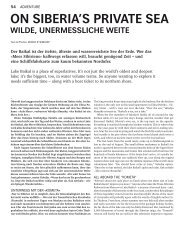GPGPU computation and visualization of three ... - ResearchGate
GPGPU computation and visualization of three ... - ResearchGate
GPGPU computation and visualization of three ... - ResearchGate
You also want an ePaper? Increase the reach of your titles
YUMPU automatically turns print PDFs into web optimized ePapers that Google loves.
Vis Comput (2011) 27: 67–81<br />
DOI 10.1007/s00371-010-0515-1<br />
ORIGINAL ARTICLE<br />
<strong>GPGPU</strong> <strong>computation</strong> <strong>and</strong> <strong>visualization</strong> <strong>of</strong> <strong>three</strong>-dimensional<br />
cellular automata<br />
Stéphane Gobron · Arzu Çöltekin · Hervé Bonafos ·<br />
Daniel Thalmann<br />
Published online: 13 August 2010<br />
© Springer-Verlag 2010<br />
Abstract This paper presents a general-purpose simulation<br />
approach integrating a set <strong>of</strong> technological developments<br />
<strong>and</strong> algorithmic methods in cellular automata (CA)<br />
domain. The approach provides a general-purpose computing<br />
on graphics processor units (<strong>GPGPU</strong>) implementation<br />
for computing <strong>and</strong> multiple rendering <strong>of</strong> any direct-neighbor<br />
<strong>three</strong>-dimensional (3D) CA. The major contributions <strong>of</strong> this<br />
paper are: the CA processing <strong>and</strong> the <strong>visualization</strong> <strong>of</strong> large<br />
3D matrices computed in real time; the proposal <strong>of</strong> an original<br />
method to encode <strong>and</strong> transmit large CA functions to<br />
the graphics processor units in real time; <strong>and</strong> clarification<br />
<strong>of</strong> the notion <strong>of</strong> top-down <strong>and</strong> bottom-up approaches to CA<br />
that non-CA experts <strong>of</strong>ten confuse. Additionally a practical<br />
technique to simplify the finding <strong>of</strong> CA functions is implemented<br />
using a 3D symmetric configuration on an interactive<br />
user interface with simultaneous inside <strong>and</strong> surface <strong>visualization</strong>s.<br />
The interactive user interface allows for testing<br />
the system with different project ideas <strong>and</strong> serves as a test<br />
bed for performance evaluation. To illustrate the flexibility<br />
<strong>of</strong> the proposed method, visual outputs from diverse areas<br />
are demonstrated. Computational performance data are also<br />
provided to demonstrate the method’s efficiency. Results indicate<br />
that when large matrices are processed, <strong>computation</strong>s<br />
S. Gobron () · D. Thalmann<br />
EPFL, IC, ISIM, VRLAB, Station 14, 1015 Lausanne,<br />
Switzerl<strong>and</strong><br />
e-mail: stephane.gobron@epfl.ch<br />
A. Çöltekin<br />
GIVA, Department <strong>of</strong> Geography, University <strong>of</strong> Zürich,<br />
Winterthurerstr. 190, 8057 Zurich, Switzerl<strong>and</strong><br />
H. Bonafos<br />
Tecnomade, 41 place Carrière, 54000 Nancy, France<br />
using GPU are two to <strong>three</strong> hundred times faster than the<br />
identical algorithms using CPU.<br />
Keywords Cellular automata · <strong>GPGPU</strong> · Simulation <strong>of</strong><br />
natural phenomena · Emerging behavior · Volume<br />
graphics · Information <strong>visualization</strong> · Real-time rendering ·<br />
Medical <strong>visualization</strong><br />
1 Introduction<br />
Cellular automata (CA) allow efficient <strong>computation</strong>s in a<br />
wide variety <strong>of</strong> fields including simulation <strong>of</strong> natural phenomena<br />
<strong>and</strong> physical processes (e.g. [8, 12, 13, 28]). CA algorithms<br />
can be even faster <strong>and</strong> more powerful when run on<br />
a graphics processing unit (GPU) [29], particularly when the<br />
input is large [11, 21, 25]. An approach that utilizes GPU accelerated<br />
real-time <strong>visualization</strong>s to identify emerging phenomena<br />
for two-dimensional (2D) CA has previously been<br />
suggested [10]. The 2D approach uses hexagonal grids <strong>and</strong><br />
is further discussed in Sect. 2.2. The study proposed in this<br />
paper extends the 2D approach by exploring the GPU-based<br />
<strong>computation</strong> <strong>and</strong> rendering <strong>of</strong> real-time Boolean multidimensional<br />
CA <strong>and</strong> implements in <strong>three</strong>-dimensional (3D)<br />
voxel space. An overview <strong>of</strong> the user interface <strong>and</strong> several<br />
example outputs can be seen in Fig. 1. This graphical user<br />
interface serves as a test bed for performance testing, benchmarking<br />
<strong>and</strong> CA-related project development.<br />
Approaches that <strong>of</strong>fer stability <strong>and</strong> speed at low <strong>computation</strong>al<br />
costs have long been desirable for real-time 3D <strong>visualization</strong>s<br />
[2, 4, 11] as well as real-time large inter-cellular<br />
<strong>computation</strong>s. An important aspect <strong>of</strong> this study is to help<br />
progress in this area by transferring massive <strong>computation</strong>s<br />
<strong>and</strong> multiple rendering <strong>of</strong> CA processes to the GPU (see<br />
Sect. 4). Several interdisciplinary communities will benefit
68 S. Gobron et al.<br />
This is followed by Sects. 6 <strong>and</strong> 7 presenting the results <strong>and</strong><br />
conclusions.<br />
2 Background<br />
2.1 Definition <strong>and</strong> a brief history <strong>of</strong> CA<br />
Fig. 1 A composite <strong>of</strong> four screenshots <strong>of</strong> the test bed that were created<br />
to evaluate the method: (a) X-ray-like rendering, (b) surface rendering,<br />
(c) simultaneous X-ray <strong>and</strong> vectorial surface rendering, <strong>and</strong><br />
(d) simultaneous rendering <strong>and</strong> 3D CA <strong>computation</strong>al interaction on<br />
the voxel structure. The implementation is provided as a freeware <strong>and</strong><br />
can be obtained at http://vrlab.epfl.ch/~stephane/<br />
from the proposed method for identifying formal CA families<br />
more efficiently. High performance gain we provide may<br />
also encourage the computer graphics community to take advantage<br />
<strong>of</strong> our approach to identify <strong>and</strong> use specific CA rules<br />
for simulation <strong>of</strong> complex phenomena or geometric transformations.<br />
Using this approach, other scientific communities<br />
dealing with 3D matrices (such as magnetic resonance imaging<br />
(MRI) in biomedical applications) can process <strong>and</strong> visualize<br />
their large data sets in real time on a common personal<br />
computer.<br />
The contributions <strong>of</strong> this paper include:<br />
A. A test bed for CA experts: The processing <strong>of</strong> a 3D<br />
regular grid CA using up to 17 million cells almost instantaneously<br />
(i.e. less than in 10 −3 seconds); The 3D <strong>visualization</strong><br />
<strong>of</strong> large 3D matrices in real time (i.e. superior to 60<br />
fps); Access to a free s<strong>of</strong>tware demonstrating the test bed using<br />
modern <strong>and</strong> common personal computers (for Micros<strong>of</strong>t<br />
Windows).<br />
B. Progress concerning coding <strong>and</strong> underst<strong>and</strong>ing CA in<br />
the world <strong>of</strong> computer graphics: The proposal <strong>of</strong> an original<br />
method to encode <strong>and</strong> transmit large CA functions to the<br />
GPUs in real time; Clarification <strong>of</strong> the notion <strong>of</strong> top-down<br />
<strong>and</strong> bottom-up approaches that non-CA experts <strong>of</strong>ten confuse;<br />
A practical technique to simplify the finding <strong>of</strong> CA<br />
functions, using 3D symmetric configuration on an interactive<br />
user interface with simultaneous interior <strong>and</strong> surface <strong>visualization</strong>s.<br />
The remainder <strong>of</strong> the paper is organized as follows. Section<br />
2 <strong>of</strong>fers a brief overview <strong>of</strong> the state <strong>of</strong> the art in the<br />
field. Section 3 documents concepts on GPU as well as<br />
terminologies on CA. Section 4 defines CA concepts <strong>and</strong><br />
presents CA processes, <strong>and</strong> Sect. 5 explains the approach<br />
allowing the <strong>computation</strong> <strong>of</strong> 3D CA using the graphics card.<br />
The concept <strong>of</strong> CA was invented in the early 1950s by J.<br />
Von Neumann reportedly upon Stan Ulam’s suggestion [14].<br />
Cellular automata can be described in several ways, but in<br />
the most generic sense it can be said that CA model <strong>and</strong><br />
mimic life as simulations. While mimicking life was perhaps<br />
the original motivation, CA should be considered more<br />
as simulators for dynamic systems—which is more general<br />
than life-like behavior.<br />
Appropriately, probably the best-known CA simulation<br />
is Conway’s “Game <strong>of</strong> Life” [3] a very simple rule set that<br />
exhibits a wide range <strong>of</strong> complex behavior—first applied<br />
to CG in [24]. This simplistic <strong>and</strong> yet complex model is<br />
<strong>of</strong>ten viewed as the source <strong>of</strong> public awareness <strong>of</strong> cellular<br />
automata, however it was Gardner who popularized it with<br />
his early 1970s publications [7, 8]. The next milestone in<br />
CA history is Wolfram’s classification <strong>of</strong> automata [26, 27].<br />
Among the more recent research, the study <strong>of</strong> excitable media<br />
is one domain that attracted wide attention, where CA<br />
models have been found useful for approximating real life<br />
behavior. Gerhardt et al. [9] designed a CA model that adheres<br />
to the curvature <strong>and</strong> dispersion properties found experimentally<br />
in excitable media [25]. A detailed survey on<br />
CA up to this date is presented by Ganguly et al. [6]. Since<br />
then, the <strong>computation</strong>al era has provided researchers with<br />
tools <strong>and</strong> infrastructure, <strong>of</strong> which a wide variety <strong>of</strong> interesting<br />
CA implementations can be found in literature, however<br />
the publications are too numerous to mention within the<br />
scope <strong>of</strong> this paper.<br />
2.2 Bottom-up <strong>and</strong> top-down approaches<br />
When studying the CA literature, the reader may feel confused<br />
about what appears to be two distinct approaches towards<br />
CA:<br />
– bottom-up approach studies the local behavior for the purpose<br />
<strong>of</strong> finding direct logic-based rules. To reach a simplified<br />
model <strong>of</strong> the original problem, a discrete system<br />
is selected that inherently possesses some necessary basic<br />
properties, e.g. symmetric structures (see Sect. 4.1);<br />
– top-down approach derives (most <strong>of</strong> the time based on<br />
poor <strong>and</strong> non-optimized discretization <strong>of</strong> mathematical<br />
function) local rules based on the specific behavior <strong>of</strong> a<br />
phenomenon. It can be defined as the transformation <strong>of</strong><br />
a differential equation into a discrete system that can be<br />
simulated on a computer.
<strong>GPGPU</strong> <strong>computation</strong> <strong>and</strong> <strong>visualization</strong> <strong>of</strong> <strong>three</strong>-dimensional cellular automata 69<br />
Table 1 Summary <strong>of</strong> the advantages <strong>and</strong> disadvantages <strong>of</strong> bottom-up or top-down approaches<br />
Advantage<br />
Disadvantage<br />
Top-down – Research topic is clearly defined – Discretization method produces error<br />
– Formulated mathematical equations – CA key-code is almost impossible to find<br />
– Combining top-down derived CA rules is very difficult,<br />
<strong>and</strong> <strong>of</strong>ten a new top-down approach must be developed<br />
Bottom-up – CA key-code derivation methods are stable – Cannot find CA key-code from a specific topic<br />
<strong>and</strong> can be repeated<br />
– Cannot easily find mathematical equation<br />
– Algorithm is faster / the most efficient<br />
– Key-codes can be combined (multiple phenomena)<br />
In the literature <strong>and</strong> especially in computer graphics texts,<br />
most examples seem to use the top-down approach <strong>and</strong> have<br />
been accepted as such with the term CA associated with it.<br />
Top-down methods are efficient for finding an approximation<br />
<strong>of</strong> a precise phenomenon (e.g. melting), <strong>of</strong>ten resulting<br />
in elegant but typically inflexible <strong>and</strong> <strong>of</strong>ten unstable solutions,<br />
as they are almost impossible to combine with others;<br />
for instance, wood on fire, heat waves, ash production, <strong>and</strong><br />
melting <strong>of</strong> the snow around the campfire.<br />
In this paper, we propose a bottom-up approach to find<br />
the CA rules <strong>and</strong> determine useful global behavior. Predicting<br />
emerging phenomena using CA has been a challenging<br />
task <strong>and</strong> <strong>of</strong>ten impossible based on theoretical approaches<br />
[27]. Hence, bottom-up approaches do not guarantee<br />
when the CA rule corresponding to such phenomena will<br />
be found.<br />
In our approach, the search process is supported with a<br />
set <strong>of</strong> real-time <strong>visualization</strong>s using transparencies <strong>and</strong> implicit<br />
surfaces to help user interpreting the CA behavior. Furthermore,<br />
for symmetrical CA, a set <strong>of</strong> geometric tools facilitates<br />
a logical crystalline construction that enables the<br />
test bed to behave as a toolbox. Based on these properties,<br />
we experimentally create CA functions until the <strong>visualization</strong><br />
gives the desired result. When found, such formal CA<br />
functions are simple to apply, extremely efficient in terms<br />
<strong>of</strong> <strong>computation</strong>al cost, <strong>and</strong> combinations <strong>of</strong> different types<br />
<strong>of</strong> behavior are possible. These properties <strong>of</strong>fer potential for<br />
multiple simulations <strong>of</strong> complex phenomena to interact with<br />
each other (e.g., complex multiple behaviors <strong>of</strong> the burning<br />
<strong>of</strong> solid objects are possible all in one model).<br />
Depending on the task <strong>and</strong>/or application, it is difficult to<br />
suggest which <strong>of</strong> the bottom-up or top-down approaches is<br />
the more efficient one. We consider both approaches to have<br />
their own unique advantages <strong>and</strong> disadvantages (Table 1).<br />
Nevertheless, an awareness <strong>of</strong> the difference between them<br />
is necessary for underst<strong>and</strong>ing CA at a fundamental level,<br />
<strong>and</strong> therefore for underst<strong>and</strong>ing the contribution <strong>of</strong> this paper.<br />
Top-down will converge to an approximation <strong>of</strong> the solution<br />
that has almost no chance <strong>of</strong> being the CA key-code<br />
(for a definition <strong>of</strong> a key-code, please refer to Sect. 3.2), <strong>and</strong><br />
that will be almost impossible to combine with other behaviors.<br />
The bottom-up solution is tedious at first, but results<br />
into the unique solution. When more than one CA key-code<br />
are found, they can easily be combined. Table 1 summarizes<br />
advantages <strong>and</strong> disadvantages <strong>of</strong> both approaches.<br />
2.3 CA <strong>and</strong> 3D on GPU<br />
Compared to the large number <strong>of</strong> 3D graphics applications<br />
on GPU (e.g. [4, 5]), top-down or bottom-up CA implementations<br />
on GPU are still rare [10, 21, 29, 30], <strong>and</strong> none were<br />
found in the literature for generic real-time bottom-up 3D<br />
CA. Current GPU implementations (e.g. [23, 29, 30]) use<br />
top-down approaches <strong>and</strong> differ from our approach from this<br />
point <strong>of</strong> view. A paper by Harris et al. [11] is perhaps one <strong>of</strong><br />
the most interesting early publications reporting a top-down<br />
implementation on GPU that is relevant to this study. They<br />
implemented an extension <strong>of</strong> CA called a coupled map lattice<br />
(CML) on early programmable graphics hardware. They<br />
achieved about 25 times faster processing over a roughly<br />
equivalent CPU implementation. While Harris et al.’s [11]<br />
paper is valuable in terms <strong>of</strong> an early demonstration <strong>of</strong> the<br />
capabilities <strong>of</strong> graphics hardware, the approach in our work<br />
is significantly different. Our study provides a generic <strong>and</strong><br />
bottom-up implementation.<br />
3 GPU <strong>and</strong> CA concepts<br />
Based on an introduction in [10], this section summarizes<br />
concepts relevant to GPU <strong>and</strong> CA.<br />
3.1 Graphics processor unit (GPU)<br />
GPU performance has increased dramatically over the last<br />
four years when compared to CPUs [15], <strong>and</strong> more recently<br />
an improvement <strong>of</strong> up to 900 times was demonstrated [10].<br />
The performance-related reports show varying numbers <strong>of</strong>
70 S. Gobron et al.<br />
how much acceleration is gained. This is due to the fact<br />
that results largely depend on the graphics card models <strong>and</strong><br />
the operating system. Nevertheless, in all cases there is a<br />
significant <strong>and</strong> consistent improvement in the reported performances.<br />
To achieve this, the graphics cards typically use<br />
<strong>three</strong> programs in their pipeline: the Vertex,theGeometric,<br />
<strong>and</strong> the Fragment Shaders also called Pixel Shaders. These<br />
<strong>three</strong> programs are illustrated on the right <strong>of</strong> Fig. 3(b). To<br />
use the graphics card as a <strong>computation</strong>al device for CA, only<br />
the last program is important as it performs <strong>computation</strong>s<br />
on single 2D textures that are used to store the 3D cellular<br />
matrix. A detailed survey <strong>of</strong> GPU architecture is not in<br />
the scope <strong>of</strong> this work, especially since we focus on CAfunctions’<br />
deduction <strong>and</strong> their CG applications. For an exhaustive<br />
review <strong>of</strong> general-purpose processing on graphics<br />
processor unit (<strong>GPGPU</strong>) the reader is recommended to refer<br />
to the Owens et al.’s [15] survey.<br />
3.2 CA terminology, concepts <strong>and</strong> definitions<br />
This section presents the terminology used in this paper including<br />
various notions <strong>of</strong> CA types, neighborhoods, rules,<br />
changes <strong>of</strong> state, <strong>and</strong> CA key-codes. Figure 2 illustrates<br />
samples <strong>of</strong> structures that present geometric properties particularly<br />
suitable for CA use. The first row proposes symmetric<br />
geometric representations for the first <strong>and</strong> second dimensions.<br />
The second row introduces the four most simple<br />
symmetric CA geometric structures for the third dimension<br />
respectively based on tetrahedron (f), <strong>and</strong> voxel-like structures<br />
(g, h, i). The bottom row presents the two possible<br />
representations <strong>of</strong> what is probably the simplest <strong>of</strong> the natural<br />
3D structures, i.e. “close packing,” with its cellular 3D<br />
shape. These are in the hexagonal close packing (j) such as<br />
platinum atoms <strong>and</strong> in the cubic close packing (k) such as<br />
silver, gold, copper, <strong>and</strong> lead atoms [16]. Considering the<br />
multitude <strong>of</strong> possible CA structures <strong>and</strong> types, the following<br />
rule is used to symbolize them all:<br />
[dimension]D [structure]<br />
[statenb]<br />
CA ≡ dDn N CA (1)<br />
with:<br />
– d as dimension;<br />
– n the number <strong>of</strong> states that a cell C can have;<br />
– N the structure:<br />
– for the square/cube structure with direct neighbors N ≡<br />
‘vN’ = 4in2D,vN st<strong>and</strong>s for von Neumann;<br />
– for the square/cube structure with indirect neighbors<br />
N ≡ ‘M i ’ = 8in2D,M i st<strong>and</strong>s for Moore with i being<br />
the growing number <strong>of</strong> possible indirect cases;<br />
– for the hexagonal grid N ≡ ‘h’ = 6in2D;<br />
– for the triangle or tetragonal structure N ≡ ‘t’ = 3in<br />
2D <strong>and</strong> = 4in 3D.<br />
Therefore, in the dDn N CA domain, for each cell C with<br />
N number <strong>of</strong> neighbors, let us define c as the number <strong>of</strong><br />
configuration structures, <strong>and</strong> ρ as the number <strong>of</strong> possible<br />
CA that can be deduced with:<br />
with c = n (N+1) <strong>and</strong> ρ = n c , then ρ = n n(N+1) . (2)<br />
For each CA <strong>of</strong> a specific type, we define a unique keycode<br />
as ϕ 1 , ϕ 2 ,..., ϕ c , describing the intrinsic local behavior<br />
for each possible state. In fact, a key-code describes the<br />
resulting column <strong>of</strong> the corresponding CA truth table. When<br />
using a top-down approach, it is almost impossible to find<br />
such a truth table (<strong>and</strong> therefore its key-code). This is because<br />
finding all local logical changes <strong>of</strong> states for each discretized<br />
behavior from a general mathematical equation is<br />
not feasible.<br />
Let τ be the truth table made with the neighbors <strong>of</strong> a central<br />
cell: A,B,C,...,X. For illustration, this “pivot” cell is<br />
located in the center <strong>of</strong> Fig. 2g, <strong>and</strong> Fig. 4 depicts all possible<br />
symmetrical rotations critically useful for symmetrical<br />
CA development <strong>and</strong> function deduction.<br />
The following section will present the proposed model<br />
for computing any rule <strong>of</strong> 3Db<br />
vN CA while enabling the <strong>visualization</strong>s<br />
<strong>of</strong> the corresponding data flow in real time.<br />
4 Processes<br />
Fig. 2 Multidimensional geometric representations appropriate for<br />
CA: (a)1D;(b)2D t ;(c)2D vN ;(d)2D h ;(e)2D M ;(f)3D t ;(g)3D vN ;<br />
(h) 3D M 1 ;(i) 3D M 2 ;(j) 3D h 1 ;(k) 3D h 2<br />
As can be seen in Fig. 3(a) the process cycle consists <strong>of</strong> <strong>three</strong><br />
main steps: input (first <strong>and</strong> second steps shown in green),<br />
processes <strong>and</strong> output. Input takes a 3D data set, a density<br />
matrix such as an fMRI scan, which is preprocessed into<br />
Tex2D. Tex2D is a 2D representation <strong>of</strong> slices, as most density<br />
data are recorded in slices. This allows the viewer to see<br />
the volume mapped into a series <strong>of</strong> slices on a single image.
<strong>GPGPU</strong> <strong>computation</strong> <strong>and</strong> <strong>visualization</strong> <strong>of</strong> <strong>three</strong>-dimensional cellular automata 71<br />
Table 2 Corresponding<br />
symmetric shape for the 128 bits<br />
3Db<br />
vN CA key-code—i.e. the<br />
neighbor’s state code Nstate<br />
Nstate<br />
Corresponding 3D vN<br />
b<br />
CA symmetric shape—see Fig. 4<br />
0..31 12343457345768911346857911579119111315<br />
32..63 3457571012571012911141657911101214161012141614161718<br />
64..95 identical to previous row<br />
96..127 6891191114169111416131517189111315141617181416171817181920<br />
Fig. 4 All symmetric configurations for Boolean direct neighbors CA<br />
CA)<br />
(3D vN<br />
b<br />
Fig. 3 Data-processing flow diagrams: (a) process cycle for the implementation<br />
that allows real-time <strong>computation</strong> <strong>and</strong> <strong>visualization</strong> <strong>of</strong> any<br />
3Db<br />
vN CA. (b) Relationship between CPU <strong>and</strong> GPUs—using a simplified<br />
representation <strong>of</strong> the GPUs architecture<br />
Several processes are integrated in the implementation<br />
<strong>and</strong> the interface (Fig. 1) allows for a number <strong>of</strong> modifications.<br />
The experimenter (test-bed user) has a great deal <strong>of</strong><br />
control over the processes. Once the 3D data set <strong>and</strong> the desired<br />
parameters are provided, the s<strong>of</strong>tware communicates<br />
with the graphics card for real-time CA <strong>computation</strong>s, as<br />
specified by the experimenter, <strong>and</strong> returns real-time <strong>visualization</strong>s<br />
<strong>of</strong> CA accordingly. During the processes symmetric<br />
<strong>and</strong> asymmetric rules are applied using a floating point variation<br />
with visual cellular behavior. All these processes are<br />
performed efficiently <strong>and</strong> they return 3D simulations, Tex2D<br />
output, <strong>and</strong> potentially valuable CA key-codes. For more details<br />
on performance, see Sect. 6.2.<br />
4.1 Symmetry rules<br />
By using (2), ρ (3D vN<br />
b CA) is equal to 2128 , approximately<br />
3.4 · 10 38 . To avoid digging r<strong>and</strong>omly into this very large<br />
number <strong>of</strong> possible Boolean CA, this method focuses on<br />
symmetric CA. As illustrated in Fig. 4, there are 20 possible<br />
symmetric configurations. Each <strong>of</strong> them can be true or<br />
false for each CA, therefore, the total number <strong>of</strong> CA is 2 20 .<br />
This greatly narrows the search space. Focusing on symmetric<br />
CA, using crystalline symmetries depicted in Fig. 4 <strong>and</strong><br />
obtaining real-time results (where both surface <strong>and</strong> interior<br />
properties can easily be visualized <strong>and</strong> interpreted) tremendously<br />
increase the chance <strong>of</strong> converging to interesting CA<br />
rules (key-codes).<br />
As illustrated in [10], symmetric CA can be very useful<br />
in the domain <strong>of</strong> real-time imaging, especially in computer<br />
graphics for automatic surface texturing or analysis <strong>of</strong> image<br />
flow.<br />
To determine the relationship between a symmetric CA<br />
function <strong>and</strong> its equivalent key-code (notice that the reciprocity<br />
is not valid), we use Table 2 that maps for each <strong>of</strong><br />
the 128 states <strong>and</strong> the corresponding 20 symmetrical configurations.<br />
The first practical example based on emerging behaviors<br />
is displayed in Fig. 5. The behavior depicts a convergence<br />
to the bounding box <strong>of</strong> each object in the scene. To achieve<br />
this, we applied a specific symmetric key-code, i.e. 1 to 20<br />
possible φ ′ were set to true, equivalent to a CA-rule with a<br />
key-code <strong>of</strong> 32φ.<br />
A second example is finding the derivative (i.e. surface<br />
normal) <strong>of</strong> a volume as described by the following key-code
72 S. Gobron et al.<br />
Fig. 5 A simple example <strong>of</strong> application in geometry using CA: finding<br />
bounding boxes on a hydrogen atom simulation database<br />
equation:<br />
ϕ true ′ =[2.4.7.8.11.12.15.16.18.20]≡<br />
τ(ϕ (1..32)<br />
=[AAAAAAAAAAAAAAA2AAAAAAA2AAA2A228]).<br />
4.2 Fragment Shaders model<br />
As previously stated, the algorithm <strong>of</strong> the 3D direct square<br />
neighbor CA is based on the relationship between a CPU<br />
program <strong>and</strong> shader codes. To make such a s<strong>of</strong>tware, <strong>three</strong><br />
main functions are required: CA <strong>computation</strong>s, the 3D CA<br />
rendering, <strong>and</strong> an interface (also referred to as human–<br />
machine interface or user interface for the interactive applications).<br />
As the first two functions are <strong>computation</strong>ally<br />
highly expensive, both are implemented using shaders. Furthermore,<br />
when there are more than six neighbors in a CA<br />
implementation, the number <strong>of</strong> key-codes produced by the<br />
s<strong>of</strong>tware becomes very high <strong>and</strong> impossible to transmit to<br />
GPU using direct addressing. To solve this problem, the keycode<br />
is encoded as a 1D-texture in our system that can easily<br />
be transmitted to the shader program.<br />
5 Methods<br />
Mentioned techniques depicted in this section are for optimizing<br />
<strong>computation</strong>s, for data <strong>visualization</strong>, <strong>and</strong> for volume<br />
rendering to help experimenters finding CA functions in an<br />
efficient manner.<br />
5.1 From 3D data set to a single 2D texture<br />
Before running the CA program, the 3D data set is precomputed<br />
into a unique 2D buffer as shown in Fig. 6. This<br />
buffer is stored in a portable network graphics (PNG) picture<br />
format consisting <strong>of</strong> a collection <strong>of</strong> slices from a density<br />
volume. This technique is convenient <strong>and</strong> efficient; it allows<br />
users to see the data set in a consistent way without requiring<br />
any additional s<strong>of</strong>tware <strong>and</strong> the “volume image” can then<br />
be directly used as a texture for the Fragment Shaders program.<br />
Furthermore, due to the natural structure <strong>of</strong> pictures,<br />
Fig. 6 Relationship between 3D matrices (a) <strong>and</strong> the equivalent 2D<br />
texture (b). As a practical example, rendered figures (c), (d), (e), <strong>and</strong> (f)<br />
illustrate a 16×16×16 matrix, <strong>and</strong> its 3D PNG, X-ray, <strong>and</strong> iso-surface<br />
representations respectively<br />
accessing neighbors between cells is easy (but not trivial)<br />
<strong>and</strong> cellular interactions are therefore very efficient. Notice<br />
that to save useless import–export <strong>computation</strong>s, this “flattening<br />
<strong>of</strong> the 3D volume” occurs at the input only, then along<br />
all GPU <strong>and</strong> CPU processes, only 3D volume (represented<br />
as 2D textures) is used. Also when storing the volume, a 3D<br />
PNG image is used as it can also be an input to the test bed.<br />
To be able to compute a 2D texture from a 3D data set<br />
using the graphics card in an efficient manner, we define a<br />
relationship between the edge size S i <strong>of</strong> the volume image<br />
<strong>and</strong> the edge size S v <strong>of</strong> the volume such that<br />
S 3 v = S2 i , with √ S v ∈ Z + . (3)<br />
The first five couples <strong>of</strong> type “[S v ,S i ]” resulting from this<br />
equation are: [2 2 , 2 3 ], [2 4 , 2 6 ], [2 6 , 2 9 ], [2 8 , 2 9 ], [2 10 , 2 15 ].<br />
Notice that the last couple represents a voxel space <strong>of</strong> 10 9<br />
cells, which is currently the most common MRI matrix size.<br />
However, due to memory issues, those very large matrices<br />
can be applied only to the latest graphics cards <strong>and</strong> their cel-
<strong>GPGPU</strong> <strong>computation</strong> <strong>and</strong> <strong>visualization</strong> <strong>of</strong> <strong>three</strong>-dimensional cellular automata 73<br />
lular interaction cannot yet run in real time. For this reason,<br />
they are not further discussed in this paper.<br />
5.2 Floating-point variation <strong>of</strong> CA<br />
Also called coupled map lattice (CML), a floating point variation<br />
<strong>of</strong> CA [11] is a technique for the simulation <strong>of</strong> natural<br />
phenomena. Instead <strong>of</strong> using a discreet change <strong>of</strong> states,<br />
like Boolean, CML allows floating numbers as states. The<br />
truth table remains valid, since a unique threshold is defined.<br />
Nevertheless, using a derivative <strong>of</strong> delta instead <strong>of</strong> 0<br />
or 1, CML permits intermediate steps (<strong>and</strong> therefore more<br />
natural visual effects) to occur. For some common functions,<br />
e.g. boiling, convection, reaction-diffusion processes,<br />
CML-CA <strong>and</strong> classical CA both converge to identical states.<br />
However, CML-CA distorts behaviors locally, then globally.<br />
While this distortion makes processes more complex, it also<br />
<strong>of</strong>fers opportunities to explore new behaviors. The test bed<br />
presented in this study provides this powerful technique as<br />
an option. CML can be selected by using non-Boolean step<br />
on the user interface (Fig. 1).<br />
To help experimenters, a visual property in the X-ray<br />
like simulation is included; this is further discussed in<br />
Sect. 5.3.2. This property is directly derived from CML:<br />
coloring the derivative <strong>of</strong> the cellular density through<br />
time. When using floating-point variation instead <strong>of</strong> direct<br />
Boolean change <strong>of</strong> state, the presented method provides<br />
a <strong>visualization</strong> <strong>of</strong> the cellular activity using color coding.<br />
That is, cells will turn red when density increases, <strong>and</strong> turn<br />
cyan when density decreases. This derivative can strongly<br />
help deducing crucial information required for defining CA<br />
emerging global behavior, as discussed in Sect. 6.<br />
5.3 Rendering <strong>of</strong> 3D CA<br />
The surface is <strong>of</strong>ten not the only important attribute, as e.g.<br />
in medical <strong>visualization</strong>s [23]. For instance, finding effective<br />
volume rendering methods for interior (inside) <strong>of</strong> object<br />
(e.g. organs) remains a challenge in the field <strong>of</strong> computer<br />
graphics. This paper does not claim to overcome this challenge;<br />
however, to study emerging 3D CA behavior, the entire<br />
3D cellular structure has to be visualized: the surface as<br />
well as the interior. For this reason, two types <strong>of</strong> rendering<br />
are proposed: X-ray-like simulation <strong>and</strong> sphere-map lighting<br />
surface rendering, including diffuse <strong>and</strong> specular sphere<br />
maps. The rendering must be in real time; they are thus both<br />
implemented in a GPU Shader. Furthermore, to be able to<br />
underst<strong>and</strong> <strong>and</strong> identify convenient CA, a simultaneous <strong>and</strong><br />
partial X-ray <strong>and</strong> iso-surface rendering has been developed<br />
(see online provided s<strong>of</strong>tware).<br />
Figure 7 displays results from the two main types <strong>of</strong><br />
Fragment Shaders algorithms that were developed to help<br />
identifying global behaviors. The surface <strong>and</strong> the interior <strong>of</strong><br />
the 3D cellular structure can be viewed on the two left images<br />
<strong>and</strong> two right images respectively. To illustrate the rendering<br />
differences, a close-up <strong>of</strong> the same region is shown<br />
on the top left <strong>of</strong> each image. Following are the details <strong>of</strong><br />
the advantages for both <strong>of</strong> these rendering techniques: X-<br />
ray-like simulation for the interior, <strong>and</strong> sphere-map lighting<br />
surface rendering for the surface.<br />
5.3.1 X-ray-like rendering<br />
Seeing inside an object is not natural, however, at times<br />
tremendously useful. A common <strong>and</strong> well-known technique,<br />
mainly used in medicine, consists <strong>of</strong> casting X-rays through<br />
biological tissues on an X-ray sensitive film. To achieve<br />
an X-ray-like <strong>visualization</strong> in our implementation, the algorithm<br />
illustrated in Fig. 8 behaves in a similar way: the<br />
idea is to cast a ray from the isometric projection (A) <strong>of</strong>the<br />
camera position on the cube, through the 3D matrix (ending<br />
in B) <strong>and</strong> find an intensity I to sum s (for ‘step’) local<br />
densities i encountered such that:<br />
∫ B B∑<br />
I = i x δ x ≃ ( x .i x ), x ← x + x (4)<br />
A<br />
x=A<br />
with x ← 1/s.<br />
For an optimal simulation, x should be the local distance<br />
from one voxel to another as the rays go through the<br />
volume. Figure 8(d) proposes a visually consistent simulation<br />
with only 50 steps.<br />
5.3.2 Adding colors to visualize cellular behavior<br />
In Fig. 9, a CA is applied that simulates the destruction <strong>of</strong><br />
weak cells <strong>and</strong> the crystallization <strong>of</strong> dense ones: from left to<br />
Fig. 7 Presenting the two rendering types, i.e. density surface <strong>and</strong> X-ray simulations, <strong>of</strong> the same 64 3 volume: (a) density voxel; (b) corresponding<br />
implicit surface; (c) X-ray-like simulation on voxel; (d) supersampling X-ray-like simulation
74 S. Gobron et al.<br />
Fig. 8 Rendering quality on a<br />
256 3 matrix, depending <strong>of</strong> the<br />
number <strong>of</strong> steps s for the X-ray<br />
simulation: (a) one step;<br />
(b) <strong>three</strong> steps; (c)10steps;<br />
(d)50steps<br />
Fig. 9 CA tool in action using<br />
X-ray <strong>visualization</strong> on a 256 3<br />
voxel space: the derivatives <strong>of</strong><br />
local densities are shown in<br />
cyan when negative <strong>and</strong> red<br />
when positive<br />
right, the converging process from the source image to a stable<br />
state can be seen. The two intermediate images demonstrate<br />
the visual property derived from CML which is the<br />
color-coding described in Sect. 5.2. The derivative <strong>of</strong> the cellular<br />
density is shown in red when positive <strong>and</strong> in cyan when<br />
negative. It can be observed that in the first phase, most cells<br />
lose density <strong>and</strong> in the second phase, the density <strong>of</strong> most<br />
remaining cells increases.<br />
5.3.3 Surface rendering<br />
To explain the selection <strong>of</strong> the rendering method, two remarks<br />
are necessary. First, it is difficult to define what is the<br />
surface <strong>of</strong> a 3D data set consisting <strong>of</strong> densities that are <strong>of</strong>ten<br />
covered with noise. Second, the use <strong>of</strong> Boolean CA requires<br />
the use <strong>of</strong> a floating threshold (e.g. 0.5 for classical CA).<br />
Based on these two observations, a threshold, defining the<br />
“solidity” limit, was used for rendering, similarly to implicit<br />
surfaces [1]. The algorithm begins by casting a ray from the<br />
eye to find the first cell that has a density superior to the<br />
threshold. Then, to find the normal <strong>of</strong> the surface, the inverse<br />
sum <strong>of</strong> all normal vectors <strong>of</strong> existing surrounding cells multiplied<br />
by their respective densities was computed. Finally,<br />
as depicted in Fig. 10, classic illumination techniques were<br />
applied. Figure 10 shows the results from the <strong>computation</strong><br />
<strong>of</strong> diffuse <strong>and</strong> specular map texture coordinates <strong>and</strong> their respective<br />
sum with a sphere-map (double) lighting.<br />
6 Results<br />
This section first provides example visual outputs from different<br />
data types to demonstrate the flexibility <strong>of</strong> the method<br />
over different domains. Then it presents <strong>computation</strong>al statistics<br />
for the presented CA method. Statistics were obtained<br />
through tests on four different hardware configurations. Finally,<br />
a discussion on the results is <strong>of</strong>fered.<br />
Fig. 10 Surface rendering pipeline: (a) normal <strong>computation</strong>s, (b) diffuse<br />
sphere map texture coordinates, (c) specularspheremaptexture<br />
coordinates, (d) <strong>and</strong>(e) corresponding diffuse <strong>and</strong> specular effects,<br />
(f) final combined rendering with sphere-map lighting<br />
6.1 Graphical results <strong>and</strong> observations<br />
CA are known to be efficient in a variety <strong>of</strong> application domains<br />
[27] ranging from mathematical physics [22] to urban<br />
studies <strong>and</strong> geography [17] <strong>and</strong> biological structures [18],<br />
to name a few. In this section, to demonstrate how the<br />
presented method behaves across some <strong>of</strong> these domains,<br />
sample results are presented for the following application<br />
fields: geometry, recursive patterns (fractals) <strong>and</strong> behavior<br />
(for bounding box <strong>and</strong> gradient), medical applications (<strong>visualization</strong><br />
<strong>and</strong> cellular interactions), simulation <strong>of</strong> natural<br />
phenomena (vegetation growth-like <strong>and</strong> surface effects).<br />
Figure 11 presents different fractal patterns generated<br />
from a single root using a low-complexity symmetric CA<br />
key-code. On the first row, the growth process <strong>of</strong> a cross-like<br />
structure from steps 2 to 40 is presented. The last figure on<br />
the right illustrates the density view <strong>of</strong> the last state. Three<br />
triangular-based fractal structures are shown on the bottom<br />
row at step 55 <strong>and</strong> the last two both depict step 40. The last<br />
image illustrates the effect <strong>of</strong> modifying a single symmetric<br />
CA parameter from the code <strong>of</strong> the recursive cross-like<br />
structure.<br />
Figure 12 illustrates the potential <strong>of</strong> the method for medical<br />
applications. Once the CA function is determined, realtime<br />
interactive effects can be computed. In this example,<br />
destructive effects over low-density tissues are computed<br />
<strong>and</strong> visualized. The close-up view shows the quality <strong>of</strong> the<br />
final rendering for a 256-side cube matrix.
<strong>GPGPU</strong> <strong>computation</strong> <strong>and</strong> <strong>visualization</strong> <strong>of</strong> <strong>three</strong>-dimensional cellular automata 75<br />
Fig. 11 An example <strong>of</strong> fractal<br />
produced from a single root cell<br />
Fig. 12 An example for medical applications: real-time CA interactive<br />
effects <strong>and</strong> high quality data <strong>visualization</strong> on the topography <strong>of</strong><br />
low-density tissues (matrix <strong>of</strong> 256 3 voxels)<br />
Fig. 14 An example for demonstrating complex surface effects (from<br />
left to right): original data (256 3 voxels) <strong>and</strong> wax-like simultaneous<br />
melting <strong>and</strong> growing<br />
Fig. 13 An example for visualizing complex natural phenomena: vegetation<br />
simulation<br />
Figures 13 <strong>and</strong> 14 present examples <strong>of</strong> natural phenomena<br />
simulations: growth <strong>and</strong> wax surface. The first figure<br />
shows vegetation growth. In the first example, notice the X-<br />
ray-like simulation in the image on the far left, where two<br />
regions are clearly distinct: while density around the leaves<br />
visibly increases (reddish color), the density inside the pot<br />
decreases (cyan color). This particular CA seems to simulate<br />
the vegetation growth process. In reality, this CA only<br />
decreases saturated density regions <strong>and</strong> increases space regions<br />
with high gradient. Concerning the wax surface simulation,<br />
this surprising CA modified the surface <strong>of</strong> the initial<br />
teapot so that the object seems to be covered by a wax layer.<br />
The real-time <strong>computation</strong> <strong>and</strong> <strong>visualization</strong> <strong>of</strong> CA is<br />
powerful, especially when underst<strong>and</strong>ing <strong>of</strong> complex data<br />
sets is necessary. In medical applications, for instance, real-<br />
time <strong>visualization</strong> <strong>of</strong> large data sets such as MRI scans is a<br />
challenge, <strong>and</strong> remains impossible on low-cost systems. Our<br />
method can be <strong>of</strong> help in some <strong>of</strong> these cases as it can h<strong>and</strong>le<br />
agrid<strong>of</strong>256 3 . To our knowledge, the best MRI grids are up<br />
to 1024 3 , thus, our method is close to allowing very low-cost<br />
3D <strong>visualization</strong> for such applications. More than a tool to<br />
only visualize in real time, our approach also allows for the<br />
processing <strong>of</strong> complex operations in real time using predetermined<br />
CA functions (such as intelligent organ detection,<br />
or growth probabilistic expectations, for instance). Different<br />
kinds <strong>of</strong> potentially useful biomedical images can be seen in<br />
various figures <strong>of</strong> this paper. In particular, Fig. 15 shows an<br />
X-ray-like simulation simultaneously with implicit surface<br />
reconstruction.<br />
6.2 Performance<br />
In this section, results are presented for acceleration <strong>of</strong> CA<br />
<strong>computation</strong>s by comparing different types <strong>of</strong> CPU or GPU<br />
based algorithms, different hardware configurations (four<br />
different graphics cards), <strong>and</strong> different data volumes (i.e.<br />
16 3 ,64 3 , <strong>and</strong> 256 3 ).
76 S. Gobron et al.<br />
Table 3 Four hardware configurations were tested; Cfg, CT-OS<br />
st<strong>and</strong>s for configuration number, computer type <strong>and</strong> operating system,<br />
<strong>and</strong> PC, NB, XP, Vst, 7, Qd, <strong>and</strong>GF st<strong>and</strong> for personal computer,<br />
notebook, Windows-XP pr<strong>of</strong>essional, Windows-Vista, Windows-7,<br />
NVidia, Quadro, <strong>and</strong> GeForce, respectively<br />
Cfg, CT-OS Graphics Card<br />
Processor <strong>and</strong> RAM<br />
#1, NB-XP Qd-FX1500M, 512 MB T7200, 1.99 GHz, 1008 MB<br />
#2, PC-Vst GF-8600-GS, 512 MB Q6600, 2.39 GHz, 3072 MB<br />
#3, NB-XP GF-7900M-GTX, 512 MB T7200, 2.00 GHz, 2048 MB<br />
#4, PC-7 GF-295-GTX, 896 MBx2 i7-920, 2.67 GHz, 6144 MB<br />
Table 4 Performance comparison for four different PCs configurations:<br />
number <strong>of</strong> CA operations per second (in millions)—see also resulting<br />
ratio in Fig. 16<br />
Fig. 15 Double <strong>visualization</strong> effects—i.e. X-ray-like <strong>and</strong> surface reconstruction—computed<br />
in a single rendering; the cyan effect represents<br />
the decreasing intensity flesh tissues: corresponding cells are programmed<br />
with a very simple cellular automaton that consists <strong>of</strong> spreading<br />
local densities towards zero or one with a predefined threshold<br />
6.2.1 Four configurations<br />
All algorithms presented in this paper were developed<br />
in C++ on Micros<strong>of</strong>t Windows XP-Pro using MSVC++,<br />
the graphics library OpenGL [20], <strong>and</strong> classical <strong>GPGPU</strong><br />
methods—i.e., OpenGL Shading Language (GLSL) [19].<br />
Some pseudo-codes are presented in the Appendix, see<br />
Figs. 17 <strong>and</strong> 18.<br />
Concerning other GPU programming methods, we would<br />
not recommend “modern” <strong>GPGPU</strong> development tools such<br />
as CUDA or OpenCL yet, even if implementation is simpler,<br />
for the following reasons. First, they remain overlays to classic<br />
Shader which—depending on the programming skills <strong>of</strong><br />
the developer—is usually less optimized. Second, direct access<br />
to texture remains impossible, which implies the resulting<br />
performance to strongly decrease. Third, CUDA remains<br />
the full property <strong>of</strong> NVidia <strong>and</strong> cannot run on ATI/AMD<br />
graphics cards.<br />
To document the efficiency <strong>of</strong> the method, its performance<br />
on common everyday computers is reported. Advantages<br />
<strong>and</strong> limitations <strong>of</strong> using graphics cards is demonstrated,<br />
in particular for 3D. Generation <strong>of</strong> the graphics card<br />
is a parameter. Table 3 presents the four hardware configurations<br />
used for testing the presented method including two<br />
notebooks, <strong>and</strong> two PCs, four different processors <strong>and</strong> four<br />
different graphics cards.<br />
6.2.2 GPU <strong>and</strong> CPU results<br />
Figure 16 illustrates the average performance for the presented<br />
method. Reported statistics are obtained by showing<br />
CPU<br />
GPU<br />
Matrices: 16 3 64 3 256 3 16 3 64 3 256 3<br />
Config.#1 42.35 29.48 4.62 40.65 105.03 11.26<br />
Config.#2 57.87 30.63 4.25 37.30 69.63 37.47<br />
Config.#3 46.50 24.83 3.59 10.63 163.77 283.01<br />
Config.#4 30.83 17.17 7.44 60.99 793.11 1731.04<br />
the <strong>computation</strong> time for 10 thous<strong>and</strong> iterations. This was<br />
done on the <strong>three</strong> possible different buffer sizes, shown in<br />
the red, green, <strong>and</strong> blue zones.<br />
Table 4 presents the number <strong>of</strong> state changes (in millions)<br />
that are computed (using CPU <strong>and</strong> GPU) every second<br />
on the <strong>three</strong> possible 3D matrices, representing 4096 cells,<br />
about 262 thous<strong>and</strong>s cells, <strong>and</strong> almost 17 million cells. The<br />
first observation is that the performances <strong>of</strong> all the CPUs<br />
quickly decreases in a very similar way as the matrices grow.<br />
The second observation is that GPU performances remain<br />
more or less identical for the 7000-series <strong>and</strong> equivalent, <strong>and</strong><br />
increase strongly for the newer series.<br />
The chart depicted in Fig. 16 displays the ratio between<br />
respective GPU <strong>and</strong> CPU capabilities. To improve its readability,<br />
a logarithmic scaling was used. Three observations<br />
can be made with regard to this chart. First, the ratio is inferior<br />
to one, there is no point in using the GPU for small<br />
3D matrices. Second, for matrices larger than 16 3 , graphics<br />
cards equivalent to or newer than the GeForce 8800GTX<br />
not only give excellent results, but demonstrate a real gap in<br />
terms <strong>of</strong> <strong>computation</strong> compared to older generations. Third,<br />
the excellent ×232 ratio is obtained with the latest graphics<br />
card, <strong>and</strong> even using best multi-core CPU with multithread<br />
algorithm, a minimum <strong>of</strong> ×30 is expected when GPU<br />
is used.<br />
These results open real possibilities for low-cost realtime<br />
massive <strong>visualization</strong>s <strong>and</strong> cellular interaction <strong>of</strong> advanced<br />
<strong>computation</strong>s. For instance, the medical domain<br />
needs very high resolution imagery implying the use <strong>of</strong> very<br />
large matrices. As previously said, this is also a domain
<strong>GPGPU</strong> <strong>computation</strong> <strong>and</strong> <strong>visualization</strong> <strong>of</strong> <strong>three</strong>-dimensional cellular automata 77<br />
Fig. 16 GPU/CPU ratio <strong>of</strong> average performance based on values in<br />
Table 4 respectively for the four hardware configurations <strong>and</strong> the <strong>three</strong><br />
matrix types (16 3 ,64 3 , <strong>and</strong> 256 3 )<br />
where intelligent 3D <strong>computation</strong> tools (such as organ detection,<br />
surgery training, tumor statistical growth prediction)<br />
are more <strong>and</strong> more needed.<br />
7 Conclusions <strong>and</strong> future work<br />
This paper presented a novel approach to simulating bottomup<br />
3D CA using the <strong>GPGPU</strong> bringing together a set <strong>of</strong> methods.<br />
A summary <strong>of</strong> key contributions can be listed as: transferring<br />
any CA <strong>computation</strong>al key-code onto the graphics<br />
card, creating a model to do the <strong>computation</strong>s for <strong>three</strong>dimensional<br />
CA, <strong>and</strong> an interactive interface (using simultaneously<br />
X-ray-like <strong>and</strong> iso-surface renderings) that helps<br />
finding convenient CA behavior. The interface is also designed<br />
to serve as a test bed for performance testing. As a<br />
result, faster CA simulations <strong>and</strong> much more efficient identification<br />
<strong>and</strong> classification are possible. Furthermore, a critical<br />
discussion was provided on two distinctly different approaches<br />
to CA based on the literature, namely top-down<br />
<strong>and</strong> bottom-up approaches.<br />
After introducing the programming techniques using<br />
both CPU <strong>and</strong> GPU, <strong>and</strong> summarizing concepts used in<br />
this application, a novel method was proposed to encode<br />
large CA key-codes allowing a generalized Boolean CA algorithm<br />
to be performed on a GPU, restricted to memory<br />
size limitations. Following that, an original method to automatically<br />
sort symmetric CA (for any dimension) based on<br />
their symmetric structure was presented. A detailed account<br />
was provided as to how to encode generalized algorithms for<br />
3D vN CA. To demonstrate the capabilities <strong>and</strong> flexibility <strong>of</strong><br />
the model, examples <strong>of</strong> characteristic patterns <strong>and</strong> common<br />
global behaviors were presented. Computational statistics<br />
obtained on different hardware <strong>and</strong> s<strong>of</strong>tware configurations<br />
demonstrated a very strong performance gain on common<br />
personal computers, especially for large 3D data sets. It was<br />
also demonstrated that the current voxel model behaves in<br />
a different way in terms <strong>of</strong> <strong>computation</strong>al capabilities depending<br />
on the graphics card generation. The solutions that<br />
are <strong>of</strong>fered in this paper will allow for a true bottom-up CA<br />
key-code (rule) discovery for potential users <strong>of</strong> CA <strong>and</strong> researchers<br />
across many fields.<br />
Following the work described in this paper, in the near<br />
future we plan to report the findings on an extended model<br />
for other <strong>three</strong>-dimensional Boolean CA with indirect neighbors,<br />
such as Moore models 3D M 1<br />
b CA <strong>and</strong> 3DM 2<br />
b<br />
CA (18 <strong>and</strong><br />
26 neighbors). Also, we believe, harmonious structures such<br />
as both hexagonal <strong>and</strong> cubic close packing 3D h CA models<br />
[16] are the most promising field <strong>of</strong> study for the 3D CA,<br />
with only 12 neighbors <strong>and</strong> the most natural structure. Nevertheless,<br />
changing the geometric nature <strong>of</strong> CA (from cubic<br />
to 3D hexagonal) will imply strong changes in the algorithm.<br />
Therefore, direct integration in the system proposed in this<br />
paper is not possible. Finally, exploring possibilities <strong>of</strong> new<br />
<strong>visualization</strong>s for this model in stereoscopic virtual environments,<br />
such as a CAVE with haptic interaction, is currently<br />
being considered.<br />
Acknowledgements We are grateful to Dr. Helena Grillon, Dr.<br />
Junghyun Ahn, <strong>and</strong> Mr. Patrick Salamin for their suggestions, which<br />
greatly improved the manuscript. We also would like to express our<br />
gratitude to the <strong>three</strong> anonymous reviewers for their valuable feedback.<br />
This work was supported by the following grants: SNF grant<br />
“GeoF” (No. 120434), SNF grant “AERIALCROWDS” (No. 122696),<br />
<strong>and</strong> the European Union COSI-ICT “CYBER-EMOTIONS” (IST FP7<br />
231323).<br />
Appendix<br />
In this appendix, pseudo-codes <strong>of</strong> the GLSL pixel-shaders<br />
for the CA rule decoding algorithm (Fig. 17) <strong>and</strong> the isosurface<br />
rendering (Fig. 18) are presented.
78 S. Gobron et al.<br />
Fig. 17 Fragment Shader used<br />
as a <strong>GPGPU</strong>: cellular automaton<br />
pseudo-code algorithm
<strong>GPGPU</strong> <strong>computation</strong> <strong>and</strong> <strong>visualization</strong> <strong>of</strong> <strong>three</strong>-dimensional cellular automata 79<br />
Fig. 18 Fragment Shader used<br />
for rendering: finding surface<br />
normal <strong>and</strong> reconstructing<br />
corresponding surface texture<br />
pseudo-code algorithm
80 S. Gobron et al.<br />
References<br />
1. Bloomenthal, J., Bajaj, C., Cani, M.P., Rockwood, A., Wyvill, R.,<br />
Wywill, G.: Introduction to Implicit Surfaces. Morgan Kaufmann,<br />
San Francisco (1997)<br />
2. Çöltekin, A., Haggrén, H.: Stereo foveation. Photogram. J. Finl.<br />
20(1) (2006)<br />
3. Conway, J.: Game <strong>of</strong> life. Sci. Am. 223, 120–123 (1970)<br />
4. Coutinho, B.B.S., Giraldi, G., Apolinario, A., Rodrigues, P.: GPU<br />
surface flow simulation <strong>and</strong> multiresolution animation in digital<br />
terrain models. In: LNCC Reports 2008. Petrópolis/RJ, Brazil<br />
(2008)<br />
5. Duchowski, A., Çöltekin, A.: Foveated gaze-contingent displays<br />
for peripheral LOD management, 3D <strong>visualization</strong>, <strong>and</strong> stereo<br />
imaging. ACM Trans. Multimedia Comput. Commun. Appl.<br />
(TOMCCAP). Arch. 3(6) (2007)<br />
6. Ganguly, N., Sikdar, B.K., Deutsch, A., Canright, G., Chaudhuri,<br />
P.P.: A survey on cellular automata. Tech. rep., Centre for<br />
High Performance Computing, Dresden University <strong>of</strong> Technology<br />
(2003)<br />
7. Gardner, M.: Mathematical games: The fantastic combinations <strong>of</strong><br />
John Conway’s new solitaire game “life”. Sci. Am. (1970)<br />
8. Gardner, M.: Mathematical games: On cellular automata, selfreproduction,<br />
the garden <strong>of</strong> eden <strong>and</strong> the game “life”. Sci. Am.<br />
(1971)<br />
9. Gerhardt, M., Schuster, H., Tyson, J.: A cellular automaton model<br />
<strong>of</strong> excitable media including curvature <strong>and</strong> dispersion. Science<br />
247, 1563–1566 (1990)<br />
10. Gobron, S., Bonafos, H., Mestre, D.: GPU accelerated <strong>computation</strong><br />
<strong>and</strong> <strong>visualization</strong> <strong>of</strong> hexagonal cellular automata. In: 8th International<br />
Conference on Cellular Automata for Research <strong>and</strong><br />
Industry, ACRI 2008, vol. 5191/2008, pp. 512–521. Yokohama,<br />
Japan, Springer (2008)<br />
11. Harris, M.J., Coombe, G., Scheuermann, T., Lastra, A.:<br />
Physically-based visual simulation on graphics hardware.<br />
In: HWWS’02: Proceedings <strong>of</strong> the ACM SIG-<br />
GRAPH/EUROGRAPHICS Conference on Graphics Hardware,<br />
pp. 109–118. Eurographics Association, Aire-la-Ville (2002)<br />
12. Durbeck, L., Macias, N.: The cell matrix: An architecture for<br />
nanocomputing. Nanotechnology 12, 217–230 (2001)<br />
13. Tomassini, M., Sipper, M., Perrenoud, M.: On the generation <strong>of</strong><br />
high-quality r<strong>and</strong>om numbers by two-dimensional cellular automata.<br />
IEEE Trans. Comput. 49(10), 1146–1151 (2000)<br />
14. von Neumann, J.: Theory <strong>of</strong> self-reproducing automata. In: Essays<br />
on Cellular Automata. University <strong>of</strong> Illinois Press, Urbana (1970)<br />
15. Owens, J., Luebke, D., Govindaraju, N., Harris, M., Krueger, J.,<br />
Lefohn, A.E., Purcell, T.J.: A survey <strong>of</strong> general-purpose <strong>computation</strong><br />
on graphics hardware. Comput. Graph. Forum 26(1), 80–113<br />
(2007)<br />
16. Phillips, W., Phillips, N.: An Introduction to Mineralogy for Geologists.<br />
Wiley, New York (1981)<br />
17. Pinto, N., Antunes, A.: Cellular automata <strong>and</strong> urban studies: A literature<br />
survey. Archit. City Environ. 1(3) (2007)<br />
18. Prusinkiewicz, P.: Modeling <strong>and</strong> <strong>visualization</strong> <strong>of</strong> biological structures.<br />
In: Proceeding <strong>of</strong> Graphics Interface ’93, pp. 128–137.<br />
Toronto, Ontario, Canada (1993)<br />
19. Rost, R.: OpenGL Shading Language, 2nd edn. Addison-Wesley,<br />
Reading (2006)<br />
20. Shreiner, D., Woo, M., Neider, J., Davis, T.: OpenGL Programming<br />
Guide: The Official Guide to Learning OpenGL v2.0, 1st<br />
edn. Addison-Wesley, Reading (2005)<br />
21. Singler, J.: Implementation <strong>of</strong> cellular automata on a GPU. In:<br />
ACM Workshop on General Purpose Computing on Graphics<br />
Processors, sponsored by ACM SIGGRAPH. Los Angeles, USA<br />
(2004). http://www.jsingler.de/studies/cagpu.php<br />
22. Smith, M.: Cellular automata methods in mathematical physics.<br />
Ph.D. thesis, Institut National Polytechnique de Grenoble (1994)<br />
23. Tatarchuk, N., Shopf, J., DeCoro, C.: Advanced interactive medical<br />
<strong>visualization</strong> on the GPU. J. Parallel Distrib. Comput. 68(10),<br />
1319–1328 (2008)<br />
24. Thalmann, D.: A lifegame approach to surface modeling <strong>and</strong> rendering.<br />
Vis. Comput. 2, 384–390 (1986)<br />
25. Tran, J., Jordan, D., Luebke, D.: New challenges for cellular automata<br />
simulation on the GPU. www.cs.virginia.edu (2003)<br />
26. Wolfram, S.: Universality <strong>and</strong> complexity in cellular automata.<br />
Physica D 10, 1–35 (1984)<br />
27. Wolfram, S.: A New Kind <strong>of</strong> Science, 1st edn. Wolfram Media<br />
Inc. (2002)<br />
28. Wu, T.-C., Hong, B.-Y.: Simulation <strong>of</strong> urban l<strong>and</strong> development <strong>and</strong><br />
l<strong>and</strong> use change employing GIS with cellular automata. In: Second<br />
International Conference on Computer Modeling <strong>and</strong> Simulation,<br />
pp. 513–516. Institute <strong>of</strong> Electrical <strong>and</strong> Electronics Engineers<br />
(2010)<br />
29. Zaloudek, L., Sekanina, L., Simek, V.: GPU accelerators for evolvable<br />
cellular automata. In: Computation World: Future Computing,<br />
Service Computation, Adaptive, Content, Cognitive, Patterns,<br />
pp. 533–537. Institute <strong>of</strong> Electrical <strong>and</strong> Electronics Engineers<br />
(2009)<br />
30. Zhao, Y.: GPU-accelerated surface denoising <strong>and</strong> morphing with<br />
lattice Boltzmann scheme. In: IEEE International Conference on<br />
Shape Modeling <strong>and</strong> Applications (SMI’08). Stony Brook, New<br />
York (2008)<br />
Stéphane Gobron during the last<br />
10 years, Stephane Gobron has<br />
mainly been—doing research in<br />
Computer Graphics where his research<br />
interests mainly focus on dynamic<br />
cellular networks, <strong>GPGPU</strong>,<br />
real-time simulation, biomedical <strong>visualization</strong><br />
tools, <strong>and</strong> augmented<br />
<strong>and</strong> virtual reality;—teaching mainly<br />
computer science in France at the<br />
undergraduate level where he also<br />
was in charge <strong>of</strong> the Computer<br />
Graphics Bachelor Department.<br />
Stephane is currently member <strong>of</strong> the<br />
VRLab, at EPLF, Switzerl<strong>and</strong>, managing<br />
a small team, focusing the R&D on 3D <strong>visualization</strong> <strong>of</strong> virtual<br />
human, <strong>and</strong> participating in teaching at graduate level.<br />
Arzu Çöltekin with a background<br />
in Geomatics Engineering in B.Sc.<br />
(4 years) <strong>and</strong> M.Sc. degrees (2<br />
years) in Istanbul, Turkey, Arzu<br />
specialized in photogrammetry <strong>and</strong><br />
remote sensing for her Ph.D. in<br />
Helsinki, Finl<strong>and</strong>. After her Ph.D.,<br />
Arzu ‘converted’ to geography <strong>and</strong><br />
currently works with an interdisciplinary<br />
research agenda where she<br />
tries to bridge concepts from human<br />
vision to <strong>visualization</strong>, <strong>and</strong> tests her<br />
findings with user experience studies.<br />
She has worked <strong>and</strong> published<br />
on web-based 3D <strong>visualization</strong>s,<br />
stereoscopic <strong>visualization</strong>s, foveation, space-variant imaging <strong>and</strong> eye<br />
tracking related topics.
<strong>GPGPU</strong> <strong>computation</strong> <strong>and</strong> <strong>visualization</strong> <strong>of</strong> <strong>three</strong>-dimensional cellular automata 81<br />
Hervé Bonafos has been for six<br />
years the reasearch <strong>and</strong> development<br />
manager <strong>of</strong> a private company<br />
(Tecnomade) in real time architectural<br />
<strong>visualization</strong>, since he graduated<br />
with a Bachelor <strong>of</strong> Science specialized<br />
in computer graphics.<br />
Daniel Thalmann is Director <strong>of</strong><br />
EPFL VRlab, Switzerl<strong>and</strong>. He is<br />
a pioneer in Virtual Humans. He<br />
is Coeditor-in-Chief <strong>of</strong> the Journal<br />
<strong>of</strong> Computer Animation <strong>and</strong> Virtual<br />
Worlds <strong>and</strong> editor or several other<br />
journals. He has published numerous<br />
papers in Graphics, Animation,<br />
<strong>and</strong> VR. He is co-author <strong>of</strong> several<br />
books, including “Crowd Simulation”<br />
(2007). He received his Ph.D.<br />
in Computer Science from University<br />
<strong>of</strong> Geneva <strong>and</strong> an Honorary<br />
Doctorate from University Paul-<br />
Sabatier in Toulouse, France.


